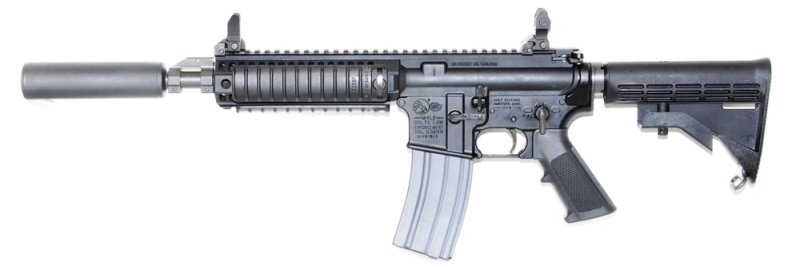5.56mm Suppressed Weapons

— AR-15 —
Building automatic weapons with sound suppressors is really a fine balancing act. Each type of auto-loading firearm has its own operating system: Blowback, Recoil, Gas – or some combination/variant of these three main systems. In the gas operated weapons there are two main types: Piston Impingement (PI), where the gas pushes against a piston as in the AK-47 or Direct Impingement (DI), where gas is routed through a gas tube to push directly against the bolt group as in the AR-15. Technically, the AR-15 has a “fixed piston – moveable cylinder” design, as stated in Eugene Stoner’s original patent. The AR-15 bolt is the fixed piston (with its obvious gas rings) and the bolt carrier bore is the close tolerance, moving cylinder. This beautiful design gives the AR-15 its completely linear recoil characteristics, unlike a piston operated system where energy is always operating off-center to the weapon’s bore axis.
Given ANY weapon design, adding a sound suppressor completely changes the original engineering and operating parameters. This simple fact escapes many people: And companies which build/market silencers (as defined by the US Government) are certainly not going to highlight this fact. Probably the greatest misunderstanding of firearms and silencers comes from television and movies – where a high-speed character takes some exotic weapon, snaps on a mythical silencer, and performs some impossible feat in near complete silence, and gets away with it. This gives the illusion that one can effortlessly install a silencer onto any type of firearm and create magical properties. Reality is far different!
The first question we need to ask is: What exactly is a “silencer?” Nothing but a high-quality tube filled with baffles of some design, capped on both ends, and secured to the firearm’s barrel or muzzle devise. How the silencer actually attaches involves some philosophy about the silencer’s purpose or mission. Should a weapon system be designed to operate normally (unsuppressed), then allow a complex “quick-detach” (QD) silencer to be attached for special situations (limited use)? OR should the weapon system be designed around a lighter, less complex, threaded silencer, attached semi-permanently to the barrel, and engineered to run suppressed all the time? The question that jumps out is: Why would one go to all the trouble and expense of designing a weapon system capable of suppressed fire and then run the weapon unsuppressed – loud?
As stated above, a sound suppressor completely alters the weapon’s operation. In very simple terms, this “baffled gun muffler” (commonly called a “can”) traps large amounts of hot gas and energy which would normally exit the muzzle. The gas confined within the suppressor overloads the AR-15’s gas system and causes damage to several areas within the weapon, most notably the lower receiver. Simply speaking, the can has overwhelmed the AR-15’s standard design and problems are coming, depending on how much the suppressor is used. From what we have learned over the past 20+ years at Specialized Armament, any AR-15 that can run without a suppressor will damage itself with a suppressor - the only question is how bad, how soon. Unfortunately many police agencies have proven this repeatedly.
Consequently, we are not fans of the QD suppressors. We firmly believe that any suppressed weapon system must be engineered around its suppressor for long term use. That means that a properly suppressed AR cannot run without its can. The custom Colt barrels used at SA have a very small gas port which limits long duration input to the gas system. These special barrels are threaded with precision class 3A threads on nearly perfect axial alignment. (normal AR barrel threads are class 2A - looser). There are also other upgraded parts within the weapon engineered to deal with full-time suppressed operation. As one notices very quickly, properly suppressed weapons are not regular animals. They are extensively refined pieces of intricate machinery.
Ken Elmore
JFK Special Warfare Center
Ft Bragg, NC (2003)
JFK Special Warfare Center
Ft Bragg, NC (2003)
Note: The weapon pictured above is a ZX6944 with a 10 inch Colt barrel machined at SA and our 6940 series gas block. This pinned SA gas block cannot be installed on any barrel that originally came from Colt with a front sight base. The sound suppressor is a GemTech TREK. Colt's upper receiver was machined to accept the KAC military rail covers. The folding sights mounted to the upper receiver are from Troy Industries. These suppressed weapons are covered at length in the Advanced M16 Armorer Classes. (2013).
PS – a final word on QD suppressors: This exotic military gear does have a place in certain very specialized units, with nearly endless budgets and classified missions. These highly-trained, non-existent people go through weapons like water. Tools of the trade.

